The Duke Lemur Center manages a population of over 200 lemurs and participates in a worldwide conservation breeding program, helping to protect the 14 endangered lemur species in our care. As members of the primate family, lemurs share a common trait with their monkey and ape relatives: they prefer to hang out in groups. While the primate order does see some solitary members, most primates group themselves into social arrangements, which provide better predator defense, help raising young, and proximity to potential mates.
These social groups can vary greatly across the primate order and even across the lemur family, ranging from smaller family units to twenty-plus member cohorts. How large and complex these groups are can affect how lemurs compete for and bond with mates, as well as how they rear offspring. In the wild, these social styles are a reflection of the environment, and aspects like food dominance and breeding dominance vary based on resource distribution. Here at the DLC, the element of resource distribution is removed, and the only limitations are physical space, genetic diversity – and personality.
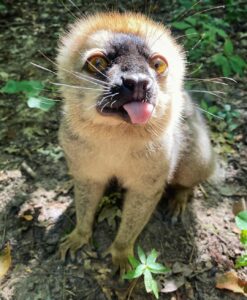
Longtime Natural Habitat Enclosure #2 resident Cardinal is a red-fronted lemur known for his sassy and assertive personality.
With such a diverse group of species and personalities at the DLC, animal care staff have learned a great deal about how to create the best social environment for the lemurs in their care. Most lemurs housed at the DLC live in pairs or family units. Despite our 50+ acres of free-range habitat, you won’t see any groups of twenty-plus lemurs in our forests. Ring-tailed lemurs might live in groups of over twenty individuals in the wild, but at the DLC, a group of six or seven is just right. Since ring-tailed lemurs adhere to a competitive social hierarchy, a smaller group means fewer battles for dominance, and fewer injuries for the DLC vet staff to tend to.
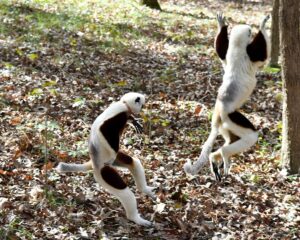
Eustace chases after his dad Marcus during a raucous playing session in Natural Habitat Enclosure #4.
Other species naturally live in smaller groups, like the Coquerel’s sifaka. Coquerel’s sifaka groups might only contain the parents and the immediate offspring, forming groups of 3-5. And on the far end of the spectrum are the nocturnal species like the dwarf lemur, mouse lemur, and aye-aye. While all of these species will maintain common sleeping sites with offspring, other family members, and even unrelated individuals in the wild, they typically spend their night time foraging hours alone. At the DLC, nocturnal animals are housed with their mates and offspring, or in their own space, where they can get plenty of alone time.
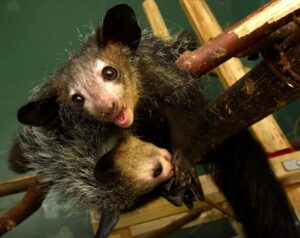
Young aye-aye Winifred will spend her first 3-4 years with her mom Fady, learning all she needs to know for her adult years.
All social lemurs at the DLC are paired with a companion, typically of the same species. Occasionally, older lemurs who no longer have family groups will be introduced to other seniors of different species, forming lemur retirement communities. These multi-species groups benefit from companionship, and don’t seem to mind their differences very much in their old age. Younger animals might be paired with a companion or a breeding partner, depending on whether or not an animal is recommended for breeding in our conservation breeding program.
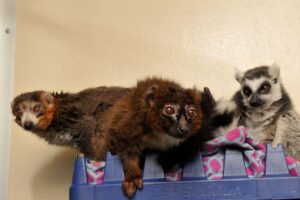
Senior lemurs Pedro (mongoose lemur), Cheyenne (red-bellied lemur), and Chloris (ring-tailed lemur) don’t mind how different they look as long as they can provide social bonding to each other.
Once decisions are made based on the data and the input of the animal care staff, it’s time to introduce the two potential mates. Lemur introductions require careful supervision from animal care staff at the start – beginning with visual access (the prospective lovebirds can see each other through adjoining fencing or across a hallway), then, if behavioral cues stay positive, they progress to meeting physically in a shared space. The best behavioral cues are bonding behaviors between the two; sitting close together, sharing food, playing, or grooming. While rejections do happen, it is not as common as the alternative! Lemurs are typically enthusiastic about their new partner, and bonding happens eventually, if not on the first “date.”

Social grooming is one of the most important and obvious behavioral cues that a pair of lemurs are bonding.
Matchmaking is only half the battle when it comes to saving species. Once the pair is bonded, the true test comes during breeding season. Most female lemurs are only receptive to breeding for a short time during the year – sometimes as short as 24 hours! Luckily, females will advertise their receptivity through behavior and through scent-marking, which helps the male know when the chance arrives. Scent communication is extremely important for lemurs all year round – marking territory, recognizing family members, and communicating health. A lemur’s scent contains a great deal of information about their physical state, so others can tell how healthy they are, what family group they’re from, and whether they’re ready to breed, just from getting a whiff. Scent is such a powerful tool in the mating game that ring-tailed lemurs are famous for their competitive “stink-fights.” Stink-fighting usually occurs between male ring-tails, who rub their wrist and shoulder scent glands on their long, stripy tails, and then wave the tails over their heads at their competitor. Males might also waft a stinky tail towards a female as a way of “stink-flirting,” the scent telling her everything she needs to know about that male. When technicians see this kind of breeding season behavior, they watch for mating, and keep their fingers crossed for a little one!
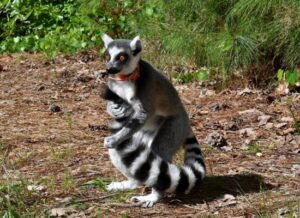
This male ring-tailed lemur is rubbing his tail with his scent glands to prepare for a stinkfight in one of the DLC’s Natural Habitat Enclosures.
While lemur social dynamics and breeding behavior can present a challenge to human caretakers, the work of conserving endangered species through conservation breeding programs is always rewarding. Whether it’s companionship, family ties, or bonds between breeding pairs, we are always hoping to encourage the love of lemurs at the DLC!

